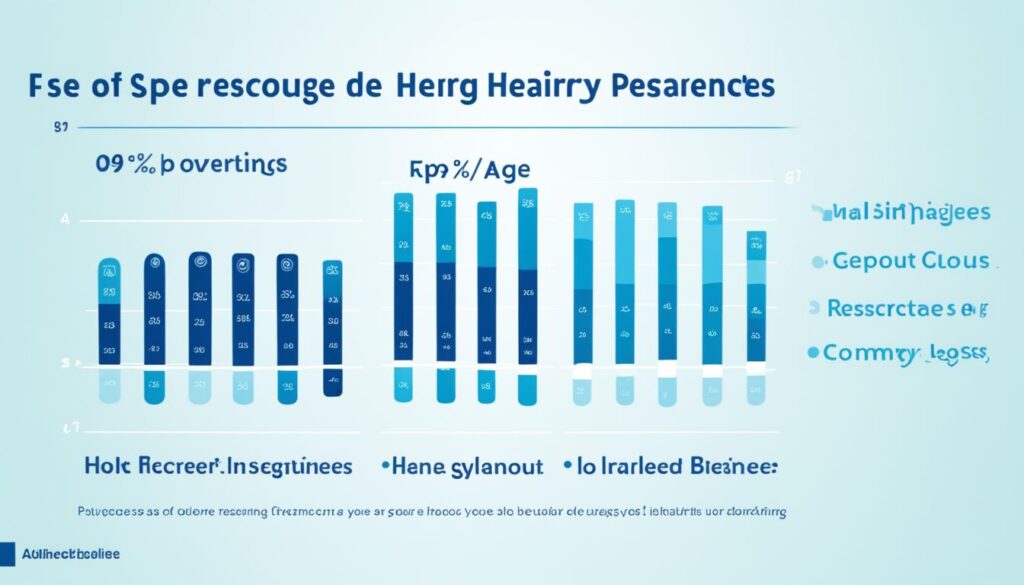Retirement Planning
Retirement Planning for Elderly with Hearing Loss
Empower your golden years even with hearing loss. Discover tailored retirement planning strategies for elderly individuals facing hearing challenges.

Hearing impairment can have a significant impact on various aspects of life, including the decision to retire. In fact, the prevalence of retirement is higher among individuals with hearing impairment compared to those without, as revealed by a study. However, when taking into account factors such as age, gender, self-reported health, and history of chronic disease, there is no significant difference in the rate of retirement between the two groups.
Key Takeaways:
- Hearing impairment can influence the decision to retire, but it is not the sole determinant.
- Retirement rates are not significantly different between individuals with and without hearing impairment.
- The average age at retirement in the United States has been increasing due to various factors, including changes in Social Security policies and the aging population.
- Deaf-friendly senior living communities provide tailored programs and accommodations for hearing-impaired individuals.
- Resources such as Social Security Disability Insurance (SSDI) and Supplemental Security Income (SSI) are available to assist deaf and hearing-impaired seniors.
The Impact of Hearing Loss on Retirement Decisions.
Retirement decisions are influenced by various factors, and hearing loss is one such factor that can play a role in this process. A study conducted on retirement rates and hearing impairment found that individuals with hearing impairment had a higher rate of retirement compared to those without. However, it’s essential to consider other factors such as age, gender, and health when exploring this association.

The study revealed that participants with hearing impairment were less likely to state that the main reason for retirement was that the time seemed right. This suggests that hearing impairment may impact the decision to retire, but it is not the sole determinant. The decision to retire is influenced by a combination of personal, financial, and health-related factors.
To fully understand the impact of hearing loss on retirement decisions, it is necessary to consider the overall context of an individual’s life, including their financial situation, social support networks, and personal goals. Retirement planning for individuals with hearing loss should involve holistic assessments and personalized strategies to ensure a successful transition into this new phase of life.
The Growing Aging Population and Hearing Loss.
In recent years, the average retirement age in the United States has been on the rise. Various factors, such as changes in Social Security policies and the need for health insurance coverage through employment, have contributed to this trend. Additionally, the aging population, particularly the baby boomer generation, is playing a significant role in the workforce, extending the retirement age.
With age, the prevalence of hearing loss tends to increase, making it a common issue among older individuals. As the baby boomer generation reaches retirement age, the number of people in the workforce with hearing impairment is expected to rise. This has important implications for retirement planning and the overall well-being of the aging population.
Retirement planning is crucial for ensuring financial security and a comfortable lifestyle during the later years of life. However, the presence of hearing loss adds an extra dimension to this process. It requires individuals to consider the potential impact of hearing impairment on their ability to work, communicate effectively, and navigate daily life in retirement.
As the aging population continues to grow, it is essential for individuals, families, and retirement planners to address the specific needs and challenges associated with hearing loss. This includes ensuring access to appropriate healthcare services, assistive devices, and support systems that can enhance the quality of life for seniors with hearing impairment.
To gain a better understanding of the relationship between the aging population, hearing loss, and retirement age, let’s take a look at the following table:
Age Group Hearing Loss Prevalence Retirement Age 50-59 20% 65 60-69 40% 67 70+ 50% 70
This table highlights the increasing prevalence of hearing loss as individuals age, coupled with the corresponding retirement age. It demonstrates the need for tailored retirement planning strategies that account for the specific challenges faced by the aging population with hearing impairment.
By acknowledging and addressing the impact of hearing loss on retirement decisions, we can ensure that individuals have the necessary resources and support to plan for their financial, social, and emotional well-being in their later years.

Challenges of Hearing Loss in the Workplace.
As individuals gradually experience hearing loss, they may encounter several challenges in the workplace. Communication difficulties can arise, particularly in settings with background noise or when interacting with a large number of people. These challenges can have a significant impact on job performance and overall well-being.
One of the primary challenges faced by hearing-impaired individuals is the difficulty in understanding conversations or instructions. Background noise can make it especially challenging to discern speech, leading to misunderstandings and confusion. This can result in errors, delays, or incomplete tasks, ultimately affecting productivity and job performance.
Moreover, communication difficulties can also give rise to frustration, anxiety, and fatigue among hearing-impaired workers. Constantly straining to hear and understand conversations can be mentally and physically exhausting, impacting overall job satisfaction and morale. The increased effort required to communicate effectively can leave employees feeling drained, causing burnout and reducing their motivation.
“In a noisy work environment, keeping up with conversations can be incredibly challenging. I often find myself asking co-workers to repeat themselves, which can be frustrating for both parties.” – Employee testimonial
The Impact on Performance
The combination of communication difficulties and the resulting fatigue can significantly contribute to a decline in job performance for hearing-impaired individuals. This can manifest in various ways, such as missed deadlines, decreased accuracy, and reduced efficiency. The inability to effectively participate in meetings or team discussions can also hinder collaboration and limit career progression opportunities.
Additionally, the challenges faced by hearing-impaired individuals may lead to increased stress levels and feelings of isolation in the workplace. This can create a negative work environment, impacting not only the individual but also their colleagues and team dynamics.
Addressing the Challenges
Employers can play a crucial role in supporting employees with hearing loss and mitigating these challenges. Implementing the following strategies can help create a more inclusive and supportive work environment:
- Providing reasonable accommodations, such as assistive listening devices or captioning services, to facilitate effective communication.
- Implementing noise reduction measures in the workplace, such as soundproofing or designating quiet areas for important conversations.
- Offering training programs to increase awareness and understanding of hearing loss among staff members.
- Encouraging open communication and creating a culture of inclusivity that values diverse abilities and perspectives.
By addressing the challenges of hearing loss in the workplace, employers can create a more supportive environment that benefits all employees and promotes productivity and job satisfaction.
Challenges Impact Recommended Strategies Communication difficulties Missed instructions, misunderstandings, reduced productivity Providing assistive devices, implementing noise reduction measures Fatigue and frustration Decreased job satisfaction, increased stress levels Offering training programs, creating an inclusive culture Decline in performance Missed deadlines, decreased accuracy, limited career progression Providing reasonable accommodations, encouraging open communication

Deaf-Friendly Senior Living Communities.
Deaf-friendly senior living communities offer a supportive and inclusive living environment for older adults with hearing impairment. These communities are designed to cater to the unique needs of the hearing-impaired population, providing a range of accommodations and services to ensure comfort and engagement.
One of the key features of these communities is the availability of tailored programs that address the needs and interests of hearing-impaired individuals. These programs may include sign language classes, communication workshops, and social activities specifically designed to foster interactions and connections among residents.

Trained staff proficient in sign language play a crucial role in deaf-friendly senior living communities. They are equipped to effectively communicate with residents, ensuring clear and meaningful interactions. This enables hearing-impaired individuals to express their needs, concerns, and preferences without any barriers.
By creating an environment where communication is accessible and embraced, deaf-friendly senior living communities empower residents to engage actively and maintain a sense of independence.
The amenities provided in these communities are specifically designed to accommodate the unique needs of hearing-impaired individuals. These accommodations may include visual alarms and notification systems, touch-friendly technology interfaces, and assistive devices such as amplified telephones and personal listening systems.
The focus of deaf-friendly senior living communities is not only on addressing the physical challenges of hearing impairment but also on creating a supportive social environment. These communities encourage residents to actively participate in social activities, fostering a sense of belonging and reducing feelings of isolation often associated with hearing loss.
Benefits of Deaf-Friendly Senior Living Communities
Deaf-friendly senior living communities offer numerous benefits to their residents. These include:
- Socialization: By providing opportunities for interaction and socialization, these communities combat the potential isolation that often accompanies hearing loss. Residents can form friendships, share experiences, and engage in meaningful social activities.
- Mental well-being: Social engagement and a sense of belonging contribute to improved mental health among hearing-impaired individuals. These communities create a supportive environment where residents can maintain positive emotional and psychological well-being.
- Physical safety: Deaf-friendly senior living communities prioritize safety by incorporating visual alarms, emergency communication systems, and other measures to ensure the physical well-being of their residents.
Overall, deaf-friendly senior living communities offer a holistic approach to senior living accommodations for individuals with hearing impairment. By addressing both the specific needs of the hearing-impaired population and providing a supportive and inclusive environment, these communities enable residents to enjoy their retirement years to the fullest.
Social and Health Benefits of Deaf-Friendly Senior Living.
Deaf-friendly senior living communities provide a supportive and inclusive environment for seniors with hearing impairments. These communities offer a range of social and health benefits that contribute to a better quality of life for their residents.
Social Benefits
One of the key advantages of deaf-friendly senior living is the emphasis on fostering social interaction and engagement among residents. These communities provide numerous opportunities for individuals to connect with others who share similar experiences and challenges. Regular social activities, such as group outings, game nights, and community events, enable residents to build friendships and cultivate a sense of belonging.
Moreover, living in a community that understands the unique communication needs of the hearing-impaired opens doors for increased socialization. With trained staff proficient in sign language and accessible communication methods, residents can actively participate in conversations, expressing themselves freely and engaging in meaningful exchanges.
Health Benefits
Besides the positive impact on social well-being, deaf-friendly senior living communities promote better overall health for their residents. These communities prioritize safety and accessibility, reducing the risk of falls and injuries. With features such as wheelchair ramps, handrails, and well-designed living spaces, seniors with hearing difficulties can navigate their environment confidently and independently.
Furthermore, research suggests that social engagement and mental stimulation can help prevent cognitive decline and reduce the risk of dementia in older adults. Deaf-friendly senior living communities provide a rich environment for creative expression and mental engagement through activities like art classes, music therapy, and educational programs.
Healthcare resources specific to the needs of hearing-impaired seniors are readily available within these communities. On-site hearing clinics, access to hearing aids, and support from specialized healthcare professionals ensure that residents receive the necessary care and support for their hearing difficulties.
“Deaf-friendly senior living communities provide a safe and supportive environment for seniors with hearing impairments, offering both social and health benefits.”

Overall, the social and health benefits of deaf-friendly senior living communities contribute to improved well-being and a higher quality of life for seniors with hearing impairments. By creating an inclusive environment that encourages social interaction and enhances physical and mental health, these communities empower older adults to thrive and enjoy their retirement years to the fullest.
Benefits of Deaf-Friendly Senior Living Social Benefits Health Benefits Encourages interaction and socializing among residents ✓ Fosters creative expression through various activities ✓ Promotes better mental health by combating isolation ✓ Reduces the risk of falls and injuries ✓ Helps prevent cognitive decline and reduce the risk of dementia ✓ Provides necessary resources for seniors with hearing difficulties ✓
Types of Senior Living for Hard-of-Hearing Adults.
For hard-of-hearing adults, there are various types of senior living options tailored to meet their unique needs. These options include deaf assisted living facilities, deaf independent living facilities, deaf skilled nursing facilities, adult daycare for hard-of-hearing adults, and home health care and aids.
Deaf assisted living facilities provide round-the-clock care and support for individuals with hearing impairment. These facilities offer personalized assistance with daily activities, medication management, and specialized programs designed to enhance the quality of life for deaf residents.
Deaf independent living facilities, on the other hand, cater to hard-of-hearing individuals who desire a greater level of independence. These facilities provide accessible accommodations, such as visual alarm systems, with an emphasis on maintaining privacy and autonomy while offering support when needed.
Deaf skilled nursing facilities are suitable for those with more complex medical needs. These facilities have trained healthcare professionals who specialize in caring for individuals with hearing impairments. They provide comprehensive medical care, rehabilitation services, and therapy tailored to meet the unique needs of hard-of-hearing residents.
In addition to these living options, adult daycare programs specifically designed for hard-of-hearing adults offer a supportive environment where individuals can socialize, engage in enriching activities, and receive personalized care during the day while returning home in the evenings.
For hard-of-hearing adults who prefer to remain in their own homes, home health care services and aids are available. These services include skilled nursing care, assistance with daily living activities, and the provision of assistive devices and technologies to support independent living.
Benefits of Different Senior Living Options for the Hard-of-Hearing
Each type of senior living facility for hard-of-hearing adults offers unique benefits and accommodations. Deaf assisted living facilities provide a supportive community and personalized care for those who require assistance in their daily lives.
Deaf independent living facilities promote independence, self-sufficiency, and a sense of belonging while ensuring accessibility and safety for residents with hearing impairments.
Deaf skilled nursing facilities provide specialized medical care and rehabilitation services, offering comprehensive support for individuals with complex healthcare needs.
Adult daycare programs for hard-of-hearing adults foster socialization, engagement, and personalized care, enabling individuals to maintain an active and fulfilling lifestyle.
Home health care services and aids allow hard-of-hearing individuals to receive personalized care in the comfort of their own homes, promoting independence and meeting their specific healthcare needs.

Type of Senior Living Services and Accommodations Deaf Assisted Living – Round-the-clock care and support
– Assistance with daily activities
– Medication management
– Specialized programsDeaf Independent Living – Accessible accommodations
– Visual alarm systems
– Emphasis on privacy and autonomyDeaf Skilled Nursing Facilities – Comprehensive medical care
– Rehabilitation services
– Specialized therapyAdult Daycare for Hard-of-Hearing Adults – Socialization and engagement
– Enriching activities
– Personalized care during the dayHome Health Care and Aids – Skilled nursing care
– Assistance with daily living activities
– Provision of assistive devices and technologies
Amenities in Deaf-Friendly Senior Living Communities.
Deaf-friendly senior living communities prioritize the comfort and safety of residents with hearing impairment, providing a wide range of amenities and services to cater to their unique needs.
Fluent American Sign Language (ASL) Staff
One of the key amenities in these communities is the availability of staff members who are fluent in American Sign Language (ASL). This ensures effective communication and allows residents to express their needs and preferences without any barriers. Having ASL fluent staff creates a welcoming environment where residents can feel understood and valued.
Emergency Communication Systems
To ensure residents’ safety, deaf-friendly senior living communities are equipped with advanced emergency communication systems. These systems include visual alarm signals and flashing lights in case of fire or other emergencies, providing crucial alerts to residents who may not rely on auditory cues. This allows for prompt evacuation and enhances overall safety within the community.
Hearing Aids and Assistive Devices
Access to hearing aids and other assistive devices is another essential amenity provided in these communities. Hearing aids can significantly improve the quality of life for residents with hearing loss by enhancing their ability to perceive and understand speech. Additionally, assistive devices such as closed-captioned televisions, amplified phones, and personal listening systems are available to further support communication and engagement.

These amenities in deaf-friendly senior living communities create a supportive and inclusive environment for residents with hearing impairment, promoting their overall well-being and quality of life.
| Amenities | Description |
|---|---|
| Fluent ASL Staff | Staff members proficient in American Sign Language for effective communication and understanding. |
| Emergency Communication Systems | Visual alarm signals and flashing lights to ensure residents’ safety during emergencies. |
| Hearing Aids and Assistive Devices | Access to hearing aids and assistive devices to enhance communication and engagement. |
Average Costs of Deaf Senior Living.
When considering senior living options for deaf and hearing-impaired individuals, it’s essential to understand the average costs associated with different types of facilities and levels of care. The cost of senior living can vary depending on factors such as location, amenities provided, and the level of support necessary.
Here is a breakdown of the average costs for deaf senior living:
Type of Facility Average Cost per Year Deaf Independent Living $42,000 Assisted Living for Deaf Seniors $45,000 Nursing Homes for Deaf or Skilled Nursing Facilities $85,000
It’s important to note that these figures are averages and can vary depending on factors such as the location of the facility and the specific services and amenities provided. Additionally, financial assistance programs and insurance coverage may be available to help offset these costs.
When considering the costs of senior living for deaf individuals, it’s crucial to assess personal financial resources, explore potential assistance options, and consider long-term financial planning to ensure a comfortable and sustainable living arrangement.

Choosing a Deaf-Friendly Assisted Living Facility.
When it comes to selecting an assisted living facility for individuals with hearing impairment, several essential factors should be considered. A deaf-friendly facility ensures a comfortable and inclusive living environment for seniors, providing the necessary support and accommodations they need.
The availability of trained staff proficient in sign language is key. Having staff members who are fluent in sign language allows for effective communication and enhances the overall experience for residents. They can understand and respond to the needs of hearing-impaired individuals, fostering a sense of connection and community.
Deaf-friendly architecture is another crucial aspect to consider. Buildings and rooms designed with the needs of hearing-impaired individuals in mind make it easier for them to navigate and interact within the facility. Features such as visual cue systems, well-lit spaces, and assistive technology can greatly enhance communication and ensure safety.
Technological advancements play a significant role in creating a deaf-friendly environment. The use of devices such as video relay services, captioned telephones, and vibrating alert systems can greatly improve communication accessibility for residents. These innovations enable individuals with hearing impairment to stay connected with their loved ones and the outside world.
Lastly, the understanding of deaf culture among the staff and management is crucial. A deaf-friendly facility embraces the unique cultural aspects of the deaf community and creates an inclusive atmosphere that respects their identity, language, and traditions.
By carefully considering these factors and choosing an assisted living facility with a focus on being deaf-friendly, individuals with hearing impairment can find a community that meets their specific needs and enhances their overall quality of life.

Resources for Deaf and Hearing-Impaired Seniors.
Deaf and hearing-impaired seniors have access to various resources that provide financial, medical, and educational assistance. These resources are designed to support individuals in overcoming the challenges they may face and ensuring they have the necessary support to lead fulfilling lives. Some of the key resources available include:
- Social Security Disability Insurance (SSDI): SSDI provides financial assistance to individuals with disabilities who are no longer able to work due to their condition. Deaf and hearing-impaired seniors may be eligible for SSDI benefits, which can help alleviate financial burdens.
- Supplemental Security Income (SSI): SSI is a needs-based program that provides assistance to individuals with limited income and resources. Eligibility for SSI benefits is determined based on various factors, including disability status. Deaf and hearing-impaired seniors who meet the criteria may qualify for SSI benefits.
- State Agencies: Many states have agencies and organizations dedicated to supporting individuals with hearing loss. These organizations can provide valuable information on services and programs available at the local level, including financial assistance, vocational training, and rehabilitation services.
- Medicaid Coverage for Hearing Services: Medicaid, a joint state and federal program, provides healthcare coverage to eligible individuals, including hearing-related services. Deaf and hearing-impaired seniors can explore Medicaid options to access necessary hearing aids, assistive devices, and other related services.
- Department of Veterans Affairs (VA): For veterans with hearing loss, the VA offers a range of benefits and support services. These may include audiology services, hearing aids, and assistive devices, ensuring veterans have access to the necessary resources to manage their hearing impairment effectively.
Additionally, there are various programs and initiatives aimed at providing education and training opportunities for deaf and hearing-impaired individuals. These programs focus on building skills, enhancing employability, and fostering independence.
By tapping into these resources and support systems, deaf and hearing-impaired seniors can access the assistance they need to navigate challenges, improve their quality of life, and confidently embrace their golden years.
Statistics about the Hard of Hearing.
Studies and research provide valuable insights into the prevalence of hearing loss in the United States. It is estimated that approximately 48 million people in the country experience some degree of hearing loss, which translates to around 15% of the population.
Furthermore, the prevalence of hearing loss increases with age, with approximately one in three people over the age of 65 experiencing some form of hearing impairment. As the population continues to age, experts predict a rise in the number of individuals affected by hearing loss.
The statistics emphasize the challenges faced by those who are hard of hearing. For example, individuals with hearing loss may encounter difficulties in the workplace, ranging from communication barriers to job discrimination. Limited access to healthcare and education can further compound the challenges faced by this population.
It is crucial to raise awareness about the impact of hearing loss and advocate for inclusive environments that support the needs of the hard of hearing community. By addressing these challenges, we can work towards a more inclusive society that embraces and empowers individuals with hearing loss.

Job Discrimination and the ADA.
The Americans with Disabilities Act (ADA) is a federal law that prohibits employment discrimination based on disability, including hearing loss. Under the ADA, employers are required to provide reasonable accommodations to employees with disabilities, including individuals with hearing loss, to ensure equal opportunity and access in the workplace.
Reasonable accommodations for employees with hearing loss can include:
- Providing sign language interpreters for meetings or training sessions
- Offering assistive technology, such as hearing aids or captioning services
- Modifying job duties or work schedules as necessary
These accommodations can help individuals with hearing loss effectively communicate and perform their job responsibilities. By providing these accommodations, employers can create a more inclusive and accessible work environment for all employees.
If an employee believes they have experienced discrimination based on their hearing loss, they have the right to file a complaint with the Equal Employment Opportunity Commission (EEOC), which enforces the ADA. The EEOC investigates complaints of employment discrimination and may take legal action on behalf of the employee if necessary.
The ADA’s protections extend to all aspects of employment, including hiring, firing, promotions, and job assignments. By promoting equal opportunity and requiring reasonable accommodations, the ADA aims to prevent discrimination and ensure that individuals with hearing loss have equal access to employment opportunities.

Key points:
– The Americans with Disabilities Act (ADA) prohibits employment discrimination based on disability, including hearing loss.
– Employers are required to provide reasonable accommodations for employees with hearing loss.
– Reasonable accommodations can include sign language interpreters, assistive technology, and modifications to job duties.
– Employees who believe they have experienced discrimination can file a claim with the Equal Employment Opportunity Commission (EEOC).
Additional Resources:
Resource Description Social Security Disability Insurance (SSDI) Provides financial assistance to individuals with disabilities, including those with hearing loss, who are unable to work. Supplemental Security Income (SSI) Offers additional financial support to low-income individuals with disabilities, including individuals with hearing loss. Department of Veterans Affairs Provides benefits and services to veterans with hearing loss, including rehabilitation, hearing aids, and assistive devices.
Benefits Available to the Hard of Hearing.
Hard-of-hearing individuals have access to various benefits and assistance programs that can support their needs and improve their quality of life. These benefits can help with the financial costs of managing hearing loss and provide resources for rehabilitation and assistive technology. Two key programs that individuals may be eligible for are Social Security Disability Insurance (SSDI) and Supplemental Security Income (SSI).
1. Social Security Disability Insurance (SSDI)
SSDI is a federal program that provides income support to individuals who have a disability, including those with hearing loss. To qualify for SSDI benefits, individuals must have worked and earned enough credits to be eligible for Social Security benefits. Additionally, they must meet the Social Security Administration’s definition of disability, which includes having a medically determinable impairment that prevents them from engaging in substantial gainful activity.
2. Supplemental Security Income (SSI)
SSI is a needs-based program that provides cash assistance to individuals with disabilities who have limited income and resources. It is administered by the Social Security Administration and can provide financial support to eligible individuals with hearing loss. To qualify for SSI benefits, individuals must meet the program’s income and resource limits, as well as the definition of disability.
State Agencies
In addition to federal programs like SSDI and SSI, state agencies also play a role in providing assistance to individuals with hearing loss. These agencies may offer programs and services such as vocational rehabilitation, education and training, assistive technology, and support for acquiring hearing aids or other communication devices. Each state has its own agencies and programs, so it’s important to reach out to the relevant state agency to explore available resources.
“Access to benefits such as Social Security Disability Insurance and Supplemental Security Income can provide vital support to individuals with hearing loss, helping them meet their financial needs and access necessary resources for rehabilitation and assistive technology.” – [Author Name]

By accessing these benefits and resources, hard-of-hearing individuals can receive the support they need to manage their hearing loss effectively. Whether it’s financial assistance, vocational training, or access to assistive technology, these programs can make a significant difference in their daily lives.
Conclusion.
Retirement planning can be a complex process for elderly individuals with hearing loss. However, there are resources and solutions available to support and empower seniors with hearing impairment throughout their retirement years. Deaf-friendly senior living communities offer tailored programs, trained staff proficient in sign language, and accommodations designed to meet the unique needs of hearing-impaired individuals. These communities provide a safe and stimulating environment, promoting social interaction and good mental health.
Additionally, various resources such as Social Security Disability Insurance (SSDI), Supplemental Security Income (SSI), and state agencies can provide financial assistance and access to hearing aids and assistive technology. By understanding the impact of hearing loss on retirement decisions and utilizing these resources, elderly individuals can navigate their retirement years with confidence and an improved quality of life.
Planning for retirement may present challenges for those with hearing loss, but with the right support and accommodations, elderly individuals can thrive in their retirement and enjoy all that life has to offer.
FAQ
What factors influence retirement decisions for elderly individuals with hearing loss?
Is there a higher retirement rate among individuals with hearing impairment?
How does the aging population contribute to retirement age?
What are the challenges of hearing loss in the workplace?
What are deaf-friendly senior living communities?
What are the social and health benefits of deaf-friendly senior living?
What types of senior living options are available for hard-of-hearing adults?
What amenities are available in deaf-friendly senior living communities?
What are the average costs of deaf senior living?
What should I consider when choosing a deaf-friendly assisted living facility?
What resources are available for deaf and hearing-impaired seniors?
What are some statistics about the hard of hearing?
How does the Americans with Disabilities Act (ADA) protect individuals with hearing loss?
What benefits are available to the hard of hearing?
How can elderly individuals with hearing loss plan for their retirement?
Lawrence founded The Liberty Portfolio to make complex retirement planning accessible to everyone. With extensive experience in investment strategies and financial planning, he leads our strategic direction and ensures that our offerings are aligned with the latest economic trends and regulations. Lawrence’s deep understanding of market dynamics and investment opportunities shapes our platform’s foundational content and tools.
Retirement Planning
Why You Need Retirement Planning Now
Kickstart your financial future with retirement planning now, ensuring a secure and comfortable retirement ahead.

Starting retirement planning now is essential for securing our financial future. By planning early, we can maximize savings, benefit from compounding interest, and have more flexibility in our retirement decisions. This proactive approach reduces stress, offers a sense of security, and sets the stage for a well-prepared financial future. Diversifying income sources, setting clear financial goals, and seeking advice are key steps. Tax benefits, peace of mind, and long-term stability come with a holistic retirement plan. Secure your future by taking the first steps today towards a comfortable retirement.
Key Takeaways
- Early retirement planning maximizes savings and leverages compounding interest.
- It provides a sense of security and reduces stress.
- Planning ahead offers flexibility and more options for retirement decisions.
- Recognizing the importance leads to a well-prepared financial future.
- Starting now ensures a stable financial future and peace of mind.
Importance of Early Retirement Planning
Starting retirement planning early is vital for securing a stable financial future. When we plan for retirement ahead of time, we set ourselves up for financial success by maximizing our savings and allowing compounding interest to work in our favor.
The benefits of early retirement planning go beyond just financial gains; it also provides a sense of security and reduces the stress and uncertainty often associated with retirement. By starting early, we've more flexibility and options available to us when the time comes to retire.
This flexibility allows us to make informed decisions about our financial future and guarantees a smoother shift into retirement life. Hence, it's important to recognize the significance of early retirement planning in order to reap the rewards of a well-prepared financial future.
Secure Financial Future Through Planning

Securing a thorough financial future through retirement planning is essential for ensuring long-term financial stability and maintaining our desired lifestyle. Planning early and diversifying sources of retirement income can provide a safety net for unexpected expenses and increasing medical costs in retirement. By setting clear financial goals and working with a financial advisor, individuals can tailor their retirement savings to meet their specific needs and aspirations. A holistic retirement plan not only considers life expectancy but also aims to fulfill retirement dreams and aspirations.
Retirement planning offers tax advantages and peace of mind by knowing that finances are in order for the future. Whether the goal is to retire early or simply to have a comfortable retirement, strategic planning is key. Investing in retirement accounts and seeking guidance from a financial advisor can help individuals achieve a secure financial future. By taking steps now to build a holistic retirement plan, individuals can pave the way for financial independence and peace of mind in their later years.
Tax Benefits of Retirement Planning

When planning for retirement, it's important to take into account the tax benefits associated with various retirement accounts. Contributing to tax-deferred accounts like traditional IRAs and 401(k)s can lower taxable income, resulting in immediate tax savings.
Utilizing Roth IRAs or Roth 401(k)s can offer post-retirement tax benefits through tax-free withdrawals. Employer-sponsored retirement accounts can also provide tax-efficient investment growth.
Understanding contribution limits and the types of retirement accounts available is vital for maximizing tax advantages. Starting a retirement plan gives you a better chance to save money on taxes and increase your Social Security benefits.
Consider consulting a Certified Financial Planner to explore advanced strategies such as the back-door Roth IRA for high earners or the Savers Credit for lower-income individuals to enhance the amount saved for retirement.
Diversifying Income for Retirement

To guarantee financial stability in retirement, it's vital to diversify income sources, creating a safety net that mitigates risks and adapts to changing circumstances.
Diversifying income sources, such as pensions, investments, and part-time work, is essential for a stable retirement. Having multiple streams of income not only provides flexibility in managing expenses but also helps in unexpected situations.
By balancing income sources, one can maintain a comfortable lifestyle and cover rising costs as well as offset market fluctuations that may impact retirement savings. This strategic approach to diversification reduces financial risk and ensures a more secure financial future.
Embracing a diversified income strategy empowers individuals to navigate retirement with confidence and resilience. Start planning now to build a robust financial foundation that can weather any storm and provide the financial power needed to enjoy retirement to the fullest.
Avoiding Financial Stress in Retirement

Taking proactive steps to address financial concerns can greatly impact one's well-being during retirement. Planning for retirement now is essential to avoid financial stress in later years. Financial stress is not just a mental burden; it can also lead to physical health issues such as diabetes and heart disease. Over 70% of adults worry about money, affecting their overall physical health. Engaging in retirement planning reduces anxiety, depression, and poor sleep, contributing to better emotional well-being. It enhances overall financial wellness, positively impacting both physical and emotional health. By taking the necessary steps to secure our financial future, we can ensure a more comfortable and stress-free retirement.
| Benefits of Retirement Planning |
|---|
| Reduces Financial Stress |
| Improves Emotional Well-being |
| Enhances Physical Health |
| Ensures Overall Financial Wellness |
Frequently Asked Questions
Why Should You Plan for Retirement Now?
We plan for retirement now to secure our future, reduce stress, and guarantee financial stability. By starting early, we take control, build wealth, and enjoy peace of mind. The power lies in proactive preparation for a comfortable retirement.
What Is the $1000 a Month Rule for Retirement?
We save with purpose. The $1000 a Month Rule for Retirement guides us. It's about securing financial freedom. By aiming for $1000 monthly income, we plan wisely, ensuring a comfortable lifestyle in retirement.
What Are the 3 Biggest Pitfalls of Sound Retirement Planning?
For sound retirement planning, we must consider inflation's erosion of savings, underestimating life expectancy leading to fund depletion, and the risk of not diversifying income sources. Our choices now shape our future security.
Why Is It Important to Plan for Retirement and Have a Will?
Planning for retirement and having a will are essential. They guarantee financial security in old age and dictate asset distribution. Both provide peace of mind and stability, preventing family disputes and maintaining desired lifestyles.
Conclusion
In summary, beginning retirement planning early is essential for a secure financial future.
Did you know that only 33% of Americans have saved over $25,000 for retirement?
By taking advantage of tax benefits, diversifying income, and avoiding financial stress, you can set yourself up for a comfortable retirement.
Don't wait, start planning now to guarantee a worry-free future.
Lawrence founded The Liberty Portfolio to make complex retirement planning accessible to everyone. With extensive experience in investment strategies and financial planning, he leads our strategic direction and ensures that our offerings are aligned with the latest economic trends and regulations. Lawrence’s deep understanding of market dynamics and investment opportunities shapes our platform’s foundational content and tools.
Retirement Planning
Evaluating the Quality of an Insured Retirement Plan
Start evaluating your insured retirement plan quality by considering benefits, costs, and tax implications – your financial future depends on it.

Evaluating an insured retirement plan's quality involves examining policy benefits, costs, cash value, fund accessibility, tax implications, surrender charges impact, and withdrawal restrictions. Evaluate if the plan aligns with your retirement goals, and seek professional advice to understand its nuances. Consider premiums, fees, and cost structures to make informed decisions. Regularly monitor cash value growth to meet financial objectives. Utilize tax-advantaged fund accessibility for stable retirement income. Be mindful of surrender charges and withdrawal restrictions to maximize plan benefits. Understanding these aspects is key to evaluating the effectiveness of your insured retirement plan further.
Key Takeaways
- Assess alignment with financial goals and retirement objectives.
- Evaluate cost structure for premiums, fees, and charges.
- Monitor cash value growth for tax-advantaged income.
- Understand tax implications on contributions and withdrawals.
- Consider impact of surrender charges and withdrawal restrictions.
Policy Benefits Evaluation
When evaluating an insured retirement plan, we prioritize the policy benefits to determine its alignment with our financial goals and retirement objectives. It's essential to take into account the insurance aspect of the plan, ensuring that it provides the necessary coverage to protect our assets and loved ones. Additionally, looking into the policy benefits related to retirement is vital. We should pay close attention to features like tax-free distributions, which can have a substantial impact on our financial situation during retirement.
As we assess the policy benefits, we must also examine how they contribute to our overall financial goals. Ensuring that the plan offers potential gains and aligns with our retirement objectives is key to making an informed decision. Moreover, policies that offer flexibility with no age requirements for certain distributions can provide us with more control over our retirement funds. Seeking professional guidance to understand the nuances of these benefits is advisable to make the most of our retirement planning.
Cost Analysis

Let's explore the analysis of costs associated with the insured retirement plan to gauge its financial impact and competitiveness. When evaluating the quality of an insured retirement plan, it is important to delve into the cost analysis. This involves examining premiums, fees, and charges to understand the financial implications and competitiveness of the plan in the market. To assist in this evaluation process, a comparison of the cost structure with similar products can provide valuable insights.
| Aspect | Details |
|---|---|
| Premiums | Initial & Ongoing |
| Fees | Management & Admin |
| Charges | Surrender & M&E |
Cash Value Assessment

Evaluating the cash value within an Insured Retirement Plan (IRP) involves examining the growth of funds held in the policy. The cash value accumulation in an IRP plays a vital role in providing a tax-advantaged income stream during retirement.
By monitoring the growth of cash value, individuals can make certain that their IRP stays aligned with their financial goals. Accessing the cash value through withdrawals or policy loans offers flexibility to meet financial needs in retirement.
It's essential to gauge the performance of the cash value component regularly to maximize the benefits of an IRP. Understanding how the cash value grows over time and how it contributes to achieving financial objectives is key to making informed decisions about the IRP.
Fund Accessibility Review

Fund accessibility in Insured Retirement Plans (IRPs) presents a tax-advantaged method for meeting financial needs during retirement. IRPs offer the flexibility of accessing funds through policy loans or tax-free withdrawals from the cash value, providing an efficient way to supplement retirement income. Policy loans enable individuals to access cash value without triggering taxable events, allowing for strategic financial planning. Withdrawals from the cash value are not subject to taxes, enhancing the overall benefits of IRPs for retirement planning. The accessibility of funds through IRPs offers significant tax advantages, making it a powerful tool for securing financial stability during retirement.
| Fund Accessibility Features | Benefits |
|---|---|
| Policy Loans | Access cash value without tax implications |
| Tax-Free Withdrawals | Provide flexibility for retirement needs |
| Retirement Income | Supplement income efficiently |
| Tax Advantages | Enhance financial planning |
| Fund Accessibility | Secure financial stability in retirement |
Tax Implications Examination

When evaluating an Insured Retirement Plan, it's important to take into account the tax implications. Understanding the tax efficiency of contributions, potential penalties for early withdrawals, and the consequences of policy surrender is vital.
Tax Efficiency Assessment
Evaluating the tax efficiency of an Insured Retirement Plan (IRP) involves analyzing the implications of contributions, withdrawals, and distributions to optimize financial outcomes. Understanding the tax treatment of cash value growth, policy loans, and tax-free death benefits is vital in evaluating the tax efficiency of an IRP. IRPs can provide tax-deferred growth on cash value, tax-free withdrawals up to basis, and potentially tax-free death benefits for beneficiaries. Proper tax planning within an IRP can maximize benefits, minimize tax liabilities, and enhance the retirement strategy's effectiveness.
| Tax Efficiency Considerations | Benefits |
|---|---|
| Cash Value Growth | Tax-Deferred Growth |
| Policy Loans | Potential Tax Advantages |
| Tax-Free Withdrawals | Up to Basis Amount |
| Tax-Free Death Benefits | Potential for Beneficiaries |
Retirement Account Contributions
As we examine the tax implications of contributing to an Insured Retirement Plan (IRP), it's important to understand that these contributions aren't tax-deductible like traditional retirement accounts.
However, the growth of these contributions within the plan is tax-deferred, and if structured correctly, withdrawals can be tax-free. The type of permanent life insurance policy chosen for the IRP can impact the tax implications.
By leveraging the cash value growth of the policy, an IRP can provide tax-advantaged retirement income. To maximize tax benefits, careful planning and contribution structuring are essential.
It's vital to take into account these factors when aiming to optimize the tax efficiency of an Insured Retirement Plan for long-term financial security.
Withdrawal Penalty Consideration
Considering the potential impact of withdrawal penalties on an Insured Retirement Plan (LIRP) is essential for long-term financial planning and growth strategies. When evaluating withdrawal penalty considerations in an LIRP, we must be aware of the following:
- Early distribution can lead to significant tax implications and reduce the policy's cash value.
- Penalties imposed by the IRS aim to deter premature withdrawals from LIRPs.
- Understanding the tax consequences of early withdrawals is critical to avoid unnecessary penalties.
- Careful planning and consideration of tax implications can help maximize the benefits of an Insured Retirement Plan.
Premium Variations Consideration

Exploring the impact of premium variations on an insured retirement plan is vital for maximizing contributions and cash value growth. Financial decisions regarding premium variations can greatly influence the policyholder's ability to boost their contributions and enhance the cash value growth of their plan.
By understanding how premium adjustments affect the plan, individuals can make informed choices to optimize their financial outcomes. Policyholders should consider the implications of different premium payment options, such as level, flexible, or single premium payments, to align with their changing financial circumstances and coverage needs.
Adapting premium variations in response to evolving situations can help secure long-term benefits and guarantee the sustainability of the insured retirement plan. It's important to evaluate premium variations thoughtfully, as they play a fundamental role in shaping the overall effectiveness and success of the retirement strategy.
Consequences of Plan Surrender

Giving up an insured retirement plan can have significant consequences, including the impact of surrender charges and analysis of withdrawal restrictions. These factors can affect the overall financial value and growth potential of the plan, influencing long-term retirement income.
It's important to carefully assess these implications before making any decisions to surrender a plan, as understanding the full scope of consequences is essential for informed retirement planning.
Surrender Charges Impact
Understanding the impact of surrender charges is vital when evaluating an insured retirement plan. Here are four key points to keep in mind:
- High surrender charges can greatly reduce the cash value of the policy, impacting potential gains.
- Policy terms often specify the surrender charge schedule, so it's essential to review this information before making a commitment.
- Early cancellation may result in financial consequences and loss of benefits, making it important to plan for the long term.
- Being aware of surrender charges can help investors make informed decisions and avoid unnecessary fees, empowering them to maximize the benefits of their retirement plan.
Withdrawal Restrictions Analysis
In evaluating the implications of surrendering an Insured Retirement Plan, it's important to analyze the restrictions on withdrawals to comprehend the full impact on financial stability and long-term retirement goals. Withdrawal restrictions can result in tax consequences and penalties, affecting retirement income and overall savings.
Plans with surrender charges may reduce the cash value available upon surrender, further diminishing potential benefits. Surrendering the plan might also limit access to tax-advantaged funds important for retirement planning. Understanding these withdrawal restrictions is essential for making informed decisions regarding the Insured Retirement Plan.
Frequently Asked Questions
What Factors Should You Consider When Evaluating a Retirement Plan?
When evaluating a retirement plan, we consider investment options, fees, and performance. We assess administrative efficiency, compliance with regulations, and communication strategies. Fiduciary responsibilities, legal compliance, reporting, and disclosure also play vital roles in our evaluation process.
What Are the 3 Important Components of Every Retirement Plan?
When planning our retirement, we focus on savings, investments, and insurance. Regular contributions build a financial cushion, diversified investments grow funds, and insurance protects against unexpected events. These components combine for a secure retirement.
How Do You Evaluate a 401K Plan?
When we assess a 401k plan, we examine its investment choices, fees, and performance against our retirement objectives. We verify that it complies with regulations, communicates effectively, and upholds fiduciary responsibilities to secure our future.
What Does a Good Retirement Plan Look Like?
A good retirement plan looks like a well-structured financial vehicle that offers diversification, tax efficiency, flexibility, inflation protection, and ongoing reviews to guarantee alignment with retirement goals. It should maximize returns and minimize risks.
Conclusion
In evaluating the quality of an insured retirement plan, it's essential to take into account:
- Policy benefits
- Costs
- Cash value
- Fund accessibility
- Tax implications
- Premium variations
- Surrender consequences
Each aspect plays a significant role in determining the effectiveness and efficiency of the plan.
By thoroughly examining these factors in parallel, you can make informed decisions to secure a stable and prosperous retirement future.
Remember, careful evaluation leads to a secure financial future.
Lawrence founded The Liberty Portfolio to make complex retirement planning accessible to everyone. With extensive experience in investment strategies and financial planning, he leads our strategic direction and ensures that our offerings are aligned with the latest economic trends and regulations. Lawrence’s deep understanding of market dynamics and investment opportunities shapes our platform’s foundational content and tools.
Retirement Planning
How to Withdraw From Your Retirement Plan
Hone your retirement withdrawal strategy with age considerations, penalty-free options, and expert advice to optimize your income – delve into the details ahead!

When withdrawing from your retirement plan, consider age requirements for penalty-free withdrawals at 59 ½. Explore strategies like lump sums or periodic payments while understanding required minimum distributions for Traditional IRAs. Seeking professional financial advice can offer tailored strategies for your needs, like managing tax implications and withdrawal rules. Tailor your plan to income needs and consider exceptions for penalty-free withdrawals, such as for home purchases. It's crucial to make well-informed decisions to secure a stable income stream in retirement.
Key Takeaways
- Consider age 59 ½ for penalty-free withdrawals from retirement plans.
- Understand different withdrawal strategies like lump sum or periodic payments.
- Be aware of Required Minimum Distributions for Traditional IRAs.
- Seek professional financial advice for personalized withdrawal recommendations.
- Tailor withdrawal strategy to match income needs and financial objectives.
Age Requirements for Penalty-Free Withdrawals
When we reach age 59 ½, we can start making penalty-free withdrawals from retirement plans. This age marks a significant milestone in our financial journey, granting us the freedom to access our hard-earned funds without facing additional taxes or penalties. It's a moment of empowerment, where we can take control of our retirement savings and utilize them strategically to support our desired lifestyle.
One key consideration at this age is the traditional IRA, which allows for penalty-free withdrawals once we reach this pivotal point. By understanding the rules surrounding withdrawals from a traditional IRA, we can optimize our financial decisions and make the most of our retirement savings. Planning ahead and being aware of the age requirements for penalty-free withdrawals is vital in managing the complexities of retirement planning.
As we approach this age, it's essential to assess our financial goals and consider how we can leverage our retirement funds to secure a prosperous future. By staying informed and proactive, we can make informed decisions regarding our withdrawals and set ourselves up for financial success in the long run.
Different Withdrawal Strategies to Consider

When planning for retirement, we can opt for a Lump Sum Option or a Periodic Payment Plan to manage our withdrawals effectively.
These strategies allow us to tailor our income stream according to our financial needs and investment goals.
Lump Sum Option
Considering different withdrawal strategies is vital when deciding on the lump sum option for your retirement account balance. A lump sum withdrawal provides immediate access to your entire account balance, but it's important to weigh the tax implications and penalties involved.
If you're under 59.5 years old, you may face a 10% penalty on the withdrawal. Additionally, the full amount taken out as a lump sum could be subject to income taxes.
To maximize your retirement income and future growth potential, explore alternative strategies like systematic withdrawals or annuitization. These methods offer more controlled ways to manage your funds while potentially reducing tax burdens and penalties.
Evaluate all options carefully before making a decision to ensure your retirement savings work most effectively for your financial goals.
Periodic Payment Plan
Exploring the Periodic Payment Plan as an alternative to lump sum withdrawals offers retirees flexibility in managing their retirement income streams. With this strategy, retirees can choose between fixed dollar amounts or systematic withdrawals, tailoring their withdrawals to meet specific income needs and goals.
It's important to weigh the tax implications and potential impact on long-term savings when opting for the Periodic Payment Plan. This method guarantees consistent income streams during retirement, providing a sense of stability and financial security.
Understanding Required Minimum Distributions (RMDs)

To comprehend Required Minimum Distributions (RMDs), we need to grasp that they're applicable to Traditional IRAs but not Roth IRAs. These distributions, mandated by the IRS, guarantee that individuals withdraw a minimum amount from their Traditional IRAs annually once they reach a certain age, currently set at 72 for 401(k)s. Failure to withdraw the required minimum could result in a tax penalty, underscoring the importance of adhering to these regulations.
When it comes to taxation, the funds withdrawn through RMDs are treated as ordinary income, impacting your tax liabilities for the year in which they're taken. It's essential to plan ahead for these distributions, considering their potential tax implications and incorporating them into your overall retirement income strategy.
Additionally, be aware that early withdrawals from Traditional IRAs before the age of 59 1/2 can trigger a 10% tax penalty on top of the regular income tax due, making it vital to understand the rules surrounding these retirement accounts to avoid unnecessary financial setbacks.
Seeking Professional Financial Advice

When planning to withdraw from a retirement plan, it's important to seek professional financial advice.
Financial advisors can provide tailored guidance to optimize retirement income and navigate tax implications.
Their expertise can help create a sustainable withdrawal strategy that aligns with both short-term financial needs and long-term retirement goals.
Expert Guidance Benefits
Seeking professional financial advice is crucial when planning for retirement withdrawals to guarantee optimal outcomes tailored to individual needs and goals. Consulting a financial advisor can provide valuable insights into withdrawal strategies, helping navigate complex tax implications effectively. Advisors offer personalized recommendations on the timing, amounts, and methods of retirement plan withdrawals, aiming to minimize taxes, penalties, and risks associated with withdrawals.
Their expertise ensures a secure and sustainable retirement income plan aligned with specific needs and objectives. By working with a financial advisor, individuals can optimize their retirement savings, making informed decisions that support long-term financial security. Expert guidance benefits individuals by offering tailored strategies that maximize retirement funds and minimize potential pitfalls.
Financial Planner Importance
Considering our unique financial situation and retirement goals, a financial planner plays a pivotal role in providing in-depth advice tailored to optimize our retirement income strategy. Seeking professional advice from a financial planner can help us navigate the intricate tax implications and withdrawal rules associated with retirement plans.
By working with a financial planner, we can develop a withdrawal strategy that maximizes our retirement income while minimizing taxes and penalties. Their expertise allows for a thorough analysis of factors such as risk tolerance, investment options, and market trends to optimize our retirement savings.
Consulting a financial planner instills confidence in our retirement plan, ensuring a secure financial future and peace of mind as we move forward.
Tailoring Withdrawal Strategy to Income Needs

Tailoring our withdrawal strategy to match our income needs in retirement involves a careful assessment of our desired lifestyle and expenses to guarantee financial stability. To secure a powerful and strategic approach, consider the following:
- Determine Your Desired Income Needs: Calculate your retirement income requirements based on your lifestyle preferences and anticipated expenses to establish a clear financial goal.
- Tailor Your Withdrawal Strategy: Customize your withdrawal plan to align with your income needs, whether you opt for a fixed or flexible approach that suits your financial objectives.
- Consult with a Financial Advisor: Seek guidance from a professional advisor to create a tailored withdrawal strategy that maximizes your retirement income potential and safeguards your financial future.
Rules and Regulations for 401(k)s

Understanding the rules and regulations governing 401(k) accounts is vital for effectively managing retirement savings. When it comes to 401(k) withdrawals, there are specific guidelines to follow.
At 59.5 years old, individuals can start withdrawing funds from their 401(k) penalty-free, although in some cases, this age threshold is lowered to 55. Mandatory withdrawals, known as required minimum distributions (RMDs), must begin at age 72, or 70.5 for certain individuals.
Early withdrawals before the age of 59.5 come with a 10% penalty in addition to income taxes. However, hardship withdrawals are exempt from the 10% penalty, though income tax payment is still required.
Additionally, 401(k) loans allow for borrowing up to $50,000 or 50% of the vested balance without incurring the 10% penalty. These loans must be repaid within five years. It's essential to adhere to these rules to maximize the benefits of your 401(k) while avoiding unnecessary penalties.
Strategies for Roth and Traditional IRAs

Exploring effective strategies for managing Roth and Traditional IRAs is vital for optimizing your retirement savings. When contemplating withdrawals from these accounts, it's important to make informed decisions to maximize your financial power. Here are three potent strategies to ponder:
- Utilize Roth IRA Contributions: Take advantage of penalty-free withdrawals on your Roth IRA contributions. By tapping into these funds strategically, you can access money without incurring additional taxes or penalties, giving you more control over your financial future.
- Plan for Traditional IRA Withdrawals: Be mindful of the tax implications and penalties associated with Traditional IRA withdrawals before age 59 ½. Consider waiting until you reach age 59 ½ to avoid the 10% penalty and make sure that you're making the most of your retirement savings.
- Leverage Exceptions: Understand the exceptions that allow for penalty-free withdrawals from both Roth and Traditional IRAs, such as first-time home purchases or qualified education expenses. By knowing and utilizing these exceptions, you can make the most of your retirement funds while staying in control of your financial destiny.
Frequently Asked Questions
Can I Pull My Retirement Money Out Whenever I Want?
Yes, we can't pull retirement money out whenever we want. IRS rules dictate specific conditions for withdrawals. Early access before 59 ½ could incur penalties. Understanding regulations safeguards savings from unnecessary losses and taxes.
Can I Close My 401K and Take the Money?
We can close a 401(k) and take the money, but it may lead to penalties. Consulting a financial advisor is essential to weigh the consequences and explore alternatives like hardship withdrawals or loans before making a decision.
How Do I Start Withdrawing for Retirement?
To start withdrawing for retirement, it's essential to understand the implications of early withdrawals. Consult a financial advisor for guidance on managing penalties and taxes, ensuring your retirement savings remain secure and optimized for future use.
Can a Retirement Plan Be Cashed Out?
Yes, a retirement plan can be cashed out, but it may incur penalties and taxes. Consider the long-term impact before making this decision. Consult a financial advisor for guidance on reaching your financial goals.
Conclusion
As we wrap up our discussion on how to withdraw from your retirement plan, remember that managing your finances is like sailing a ship on the open sea.
Stay the course, adjust your sails as needed, and seek out the guidance of experienced captains along the way.
With careful planning and strategic decision-making, you can confidently sail into the sunset of retirement, knowing that your financial future is secure.
Fair winds and following seas on your retirement journey!
Lawrence founded The Liberty Portfolio to make complex retirement planning accessible to everyone. With extensive experience in investment strategies and financial planning, he leads our strategic direction and ensures that our offerings are aligned with the latest economic trends and regulations. Lawrence’s deep understanding of market dynamics and investment opportunities shapes our platform’s foundational content and tools.
-

 IRA Investing3 months ago
IRA Investing3 months agoUnderstanding Your Individual Retirement Account (IRA): Types, Investments, and How It Works
-

 Bitcoin IRA3 months ago
Bitcoin IRA3 months agoBitcoin IRA Gold: Secure Your Retirement Savings
-

 IRA Investing3 months ago
IRA Investing3 months agoHow Are Roth IRAs Invested?
-

 IRA Investing3 months ago
IRA Investing3 months agoIRA Investing Basics
-

 Bitcoin IRA3 months ago
Bitcoin IRA3 months agoEthereum IRA: Invest in Crypto with Your Retirement Fund
-

 Gold IRA3 months ago
Gold IRA3 months agoDiscover the Advantages of a Gold Retirement Account
-

 Bitcoin IRA3 months ago
Bitcoin IRA3 months agoIs Bitcoin IRA Tax Free?
-

 Bitcoin IRA3 months ago
Bitcoin IRA3 months agoUltimate Guide to Crypto IRA Investment Options
























